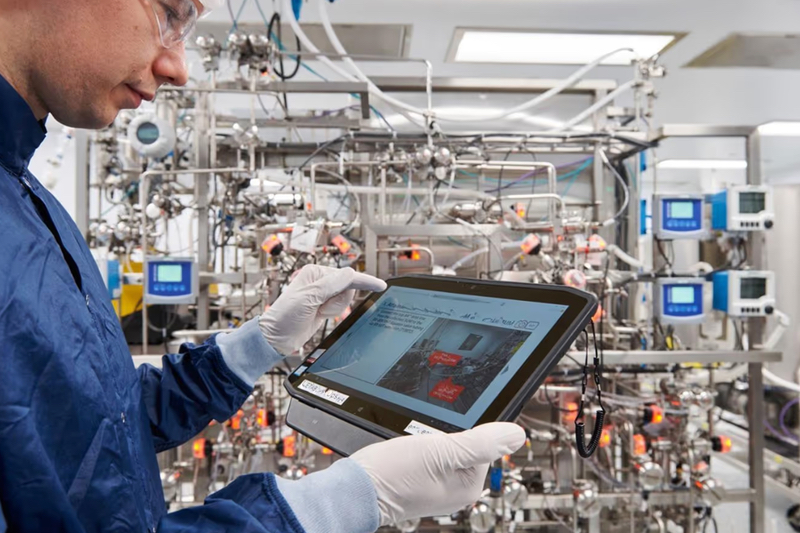With a wide variety of novel therapies working their way through the drug development pipeline — from mRNA vaccines to peptide therapeutics to exciting new cell and gene therapies — groundbreaking scientific advancements have continued to pave the way for pharmaceutical development and manufacturing. We can expect these trends to continue during the next decade to deliver a slew of advanced therapies.1
As therapies become more complex, the manufacturing technologies used to develop and bring them to market must also evolve.2 Luckily, we can see some of the elements that enable the realistic implementation of advanced technologies in practice through recent innovation and real-world examples, namely the 2024 International Society for Pharmaceutical Engineering (ISPE) Facility of the Year Awards (FOYA) category winners.
Advanced therapies will require pharma companies to update the production and supply chain ecosystem
The snowball effect of implementation
Advanced treatments such as complex biologics and cell and gene therapies can require more time, money and specialised processes to produce than conventional ones. Although some established manufacturing technologies can be repurposed in the short-term, the increasingly individualised and precise nature of advanced therapies will require pharma companies to update the production and supply chain ecosystem to support them.
When bringing an advanced therapy to market, manufacturers must consider more than just the efficacy of the medicine. They must also ensure that the downstream scaling and manufacturing infrastructure is in place to enable the therapy to reach patients in a timely, cost-effective manner. Simply put, evolving therapies require a next-generation manufacturing ecosystem.
There are many innovative pharmaceutical manufacturing technologies that show immense potential to improve the speed and quality of therapies. The actual implementation of innovative technology often relies on a “snowball effect” whereby a handful of trendsetters implementing an innovative technology sets off a wave of more widespread adoption and further development of the initial concept. To initiate the cascade of implementation, however, there are several key barriers that must be overcome — from ensuring the maturity of the technology to enabling the navigation of regulatory approvals.
The role of technological maturity in AI implementation
Realistic implementation of an advanced technology is centred on its maturity. This is particularly important when considering that the safety and treatment of patients can be impacted by technological failure. Although some new technologies might be flashy or exciting
on paper, if they aren’t well-tested or implemented with proper safeguards and regulatory support, widespread implementation will be more challenging. 
Even worse, a single high-profile setback could hinder that implementation for decades to come. AI is an excellent example of a “hot” technology that currently exists at an earlier stage of maturity. Whereas automation has matured and is seeing increased implementation in pharmaceutical manufacturing facilities, AI is still in the relatively early stages of implementation.
As we look to industry trendsetters, AI is currently being used in small but meaningful ways throughout the drug development pipeline (such as drug discovery) that can help us to see what the future might be for this technology.3 For example, Zydus Pharmaceuticals, which received recognition with a 2024 ISPE FOYA Honorable (sic) Mention, is making use of AI-enabled robots to streamline material transfer operations in an oral solid dosage (OSD) facility.4 This is an example of how AI’s integration with other technologies, including automated systems, could be a powerful asset in the development of precision therapies.
In future decades, we could see AI driving the automation of continuous flow processing or optimising operations based on manufacturing execution system (MES) data across multiple manufacturing lines for long periods of time. However, with so much attention on AI technology, it is more important than ever for the industry to focus on the best implementation use cases and not just the flashiest.
Revalidating a manufacturing process for significant upgrades can be expensive and impact access to therapies
PAT and continuous manufacturing throughout the drug lifecycle
Another key consideration to facilitate the uptake of advanced technologies is implementation in a manner that makes sense throughout the entire lifecycle of a therapy, both procedurally and economically. Revalidating a manufacturing process for significant upgrades can be expensive and impact access to therapies. This has, historically, been one barrier to the implementation of advanced manufacturing technologies.
Now, however, the development of new therapies has facilitated new manufacturing techniques and infrastructure. When a technology can be implemented from the beginning — in early research and development stages — it becomes easier to integrate it into manufacturing processes at scale.
Eli Lilly’s IE2b facility in Kinsale, Ireland, which earned the company a 2024 ISPE FOYA for Innovation, provides a helpful example of effective early technology implementation with process analytical technology (PAT) and continuous manufacturing.5 Successful implementation of these technologies has been a goal for decades.6 However, until recent years, the technology and systems haven’t been mature enough to reach widespread adoption. The benefits of PAT and continuous manufacturing are becoming fundamental to the future development of more complex therapeutics.7,8
Although the IE2b facility could have relied on the traditional synthetic peptide manufacturing process, they instead chose to develop a first-of-its-kind hybrid API synthetic peptide manufacturing platform from the ground up — layering PAT, continuous flow manufacturing,
advanced nanofiltration systems and digital systems. This implementation required extensive amounts of trial and error, problem solving and engineering, along with close collaboration with regulators.
Ultimately, these technologies have been applied in an intentional and logical way that amplifies their benefits: increased throughput, shorter production times, improved product quality, better control of the production process, reduced environmental impact through the reduction of waste and enhanced long-term data insights.
Regulatory validation through comprehensive data system implementation
Regulatory approval and validation are crucial aspects of successful technology implementation. The pharmaceutical industry is well-regulated because the safety of patients is at stake. Still, regulations can pose limitations to the implementation of new technology, particularly because of the wealth of data and careful navigation required. For this reason, close partnerships with regulatory agencies and careful data management are a must for the successful validation of an innovative manufacturing facility. 
MES and historian systems are another advanced technology with extensive potential to benefit the production of advanced therapies, namely by optimising processes and enabling the streamlined fulfilment of regulatory responsibilities. These systems can give teams a much better understanding and control of the operations within a manufacturing line. Historically, the wealth of data supplied by these systems was challenging to balance and use for insightful decision making. Now, however, the rise in digitisation has improved the value and implementation of these systems, helping product teams to optimise their processing; this often translates to increased yields while reducing energy expenditures and waste. In addition, these insights can reduce downtime and help to spot and mitigate problems before they arise.
Takeda’s prefilled syringe filling line in Linz, Austria, which won the 2024 ISPE FOYA “Operations – Facility Fit” category, highlights this idea. Part of this project entailed integrating the MES and historian system, which allowed the team to create a central platform for improved data accessibility. Paired with automation throughout the facility, these technologies help to make the plant more efficient and effective. In fact, the facility was able to complete all process performance qualification (PPQ) runs within a 24-month timeline, 50% faster than the industry
standard.
Advanced therapies enabled through advanced technologies
The world of pharmaceutical manufacturing is changing. We’re at an opportune time when newly developed therapies can be paired with the incorporation of innovative technology across development pipelines. As shown by the ISPE FOYA category winners and innovators like them, we can see examples of newly mature technology getting its moment to shine and a vision of what the next decades of pharmaceutical manufacturing innovation might hold.
With increased visibility into the technologies of the future, the industry can remain hopeful that these technologies will become widely accepted, the logistics and infrastructure to support them will become better established and their potential for patients and the industry alike will be fully realised.
[Image Credit: Sanofi, 2021]
References
1 E. Hanna, et al., “Advanced Therapy Medicinal Products: Current and Future Perspectives,” J. Mark. Access Health Policy 4 (2016): doi:10.3402/jmahp.v4.31036.
2 J. Tarnowski, et al., “Delivering Advanced Therapies: The Big Pharma Approach,” Gene Ther. 24(9), 593–598 (2017): doi:10.1038/gt.2017.65.
3 L.K. Vora, et al., “Artificial intelligence in Pharmaceutical Technology and Drug Delivery Design,” Pharmaceutics 15(7), 1916 (2023). doi:10.3390/pharmaceutics15071916.
4 https://ispe.org/facility-year-awards/winners/2024/honorable-mention-2.
5 https://ispe.org/facility-year-awards/winners/2024/innovation.
6 www.fda.gov/regulatory-information/search-fda-guidance-documents/pat-framework-innovative-pharmaceutical-development-manufacturing-and-quality-assurance.
7 B. Wang, et al., “Process Analytical Technologies in Cell Therapy Manufacturing: State‐of‐the‐Art and Future Directions,” J. Adv. Manuf. Process 4(1) e10106 (2022).
8 C.L. Burcham, A.J. Florence and M.D. Johnson, “Continuous Manufacturing in Pharmaceutical Process Development and Manufacturing,” Annu. Rev. Chem. Biomol. Eng.9 253–281 (2018).
9 https://ispe.org/facility-year-awards/winners/2024/operations.
